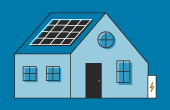Designing a “storage-ready” solar panel system is the first step to ensuring that you’re set up for success when you decide to move forward with a solar battery for your home or business. EnergySage spoke with Timothy Stocker, Product Manager, Energy Storage at SMA America for his perspective on storage-ready solar.
What is the value proposition for a “storage-ready” solar product for residential customers?
The value proposition for an on-grid storage-ready solution for residential customers is that it gives the end customer the option to add storage at the time of PV installation or at a later date with minimal effort. The customer may not have the resources to install storage at the time, or may not be in a utility service territory where it would make sense to add storage, so a storage-ready solution offers great flexibility. For backup-based applications, it makes sense to install storage at the time of the solar project due to the complexity of such installation.
Who should consider installing a storage-ready solar option now?
People in high energy usage areas like Hawaii and Arizona should consider installing a storage-ready solar option now, as well as people who live in areas where utility policies are in flux (such as Nevada, where the net metering debate is happening) – or anywhere where rate structures have shown some volatility. Anyone who lives in areas of inclement weather where hurricanes, superstorms and other unpredictable weather patterns are common should also consider this option.
For on-grid customers who cannot budget for a storage system at the time of installation or are in a utility territory where storage doesn’t make sense right away, a storage ready system can help alleviate some burdens. This is really only the case with a DC-coupled architecture that requires you to add hardware that will not be used until the energy storage system (i.e. battery) is installed. Installing a storage-ready system in an AC-coupled architecture is quite simple and can be as easy as adding a breaker, or for more advanced installers, installing an “energy system ready” load panel, which includes a 60+ amp-rated feeder directly tied to the meter.
Consumers should keep in mind that in order to easily claim the Investment Tax Credit (ITC) for the storage portion of a system, it should be installed at the same time as the PV portion. If the storage system is installed later, claiming the ITC is more difficult. Other incentive programs can help with this problem, such as California’s Self Generation Incentive Program (SGIP), which helps fund the capital investment and has performance guarantees associated with it.
What criteria do you recommend shoppers look for when considering their storage-ready options?
Power capacity vs. energy capacity – Customers should be familiar with power and energy requirements, and kilowatt (kW) vs. kilowatt hour (kWh). Customers and installers should be aware of the power requirements for a customer’s household load, depending on the application. Batteries are sized in kW and kWh, whereas inverters are just sized in kW or instantaneous power. It’s best to make sure the inverter is properly aligned with the battery in terms of power capacity to fully utilize the inverter’s power output. Shoppers should also ask how to increase their capacity in a system without having to add another inverter, even when they don’t need the extra power.
Backup needs – Customers should be aware of the product’s backup options. They should ask how it works, what other hardware is required, and what the load/power requirements are. Backup calculations can quickly get complicated because the calculation requires a load study to determine what the system characteristics should look like.
Future proofing – Customers should familiarize themselves with the brands that will be installed. How stable is the company/brand? How long have they been around? What will happen if they go bankrupt, and how will that affect the customer’s warranty? What does their service and support structure look like? This is extremely important with battery manufacturers, as we have seen many come and go, and this will continue to be the trend as the market grows. Another question to ask is, “What happens when I want to add more energy capacity (kWh)”? Choosing the right products and right technology will ultimately allow the customer to hit their ROI sooner and complete the shift from a consumer to a prosumer.
How is SMA America’s storage-ready offering different from other options on the market?
SMA’s new Sunny Boy Storage–US battery inverter, which will start delivery later this year, is an AC-coupled architecture inverter that allows for easy installation regardless of the PV system. This means you design and install it independently of a renewable energy system, which allows for the best flexibility and scalability. It features three independent DC inputs that can be attached to three different batteries from three different manufacturers with three different chemistries and three different voltage windows. This is incredibly unique, and allows for ultimate future proofing. As we saw with Tesla’s Powerwall 1, it’s hard to know how long a battery storage manufacturer will produce and support its products. Having multiple independent DC inputs allows customers to use the latest technology without having to worry about compatibility issues in the future.
The Sunny Boy Storage-US product line includes built-in energy management functions to best match different use cases, such as time-of use (ToU) or zero-export using a meter from our qualified energy meter supplier list.
SMA’s Backup Unit will allow for whole-home backup or a protected-loads panel, depending on the customers need.
What types of storage options (e.g. battery systems) are compatible with your offering?
Ultimately SMA’s inverter is battery agnostic, but the battery does need to fit within the voltage input window of the inverter (150 – 550 Vdc) and the battery needs to communicate with the inverter though the BMS interface. The Sunny Boy Storage-US inverter is compatible with many battery manufacturers including LG Chem and others as they come to market with their products. SMA specifically engineered the Sunny Boy Storage to offer the industry’s most versatile solution, simplifying the job of PV installers.











